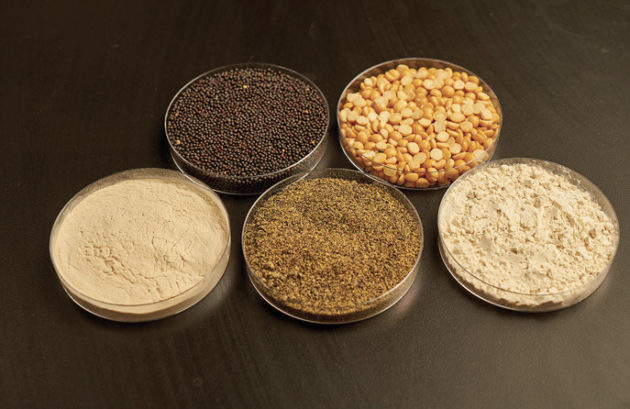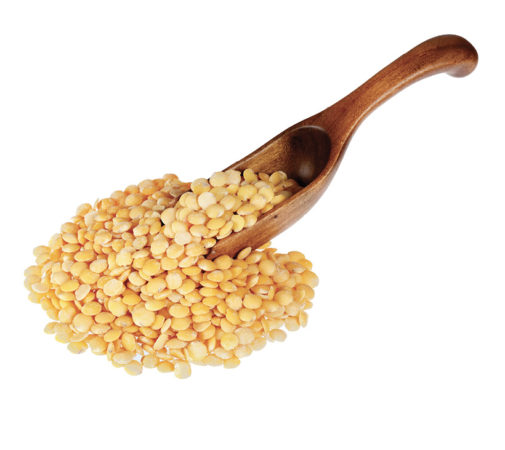
Plant-based protein in demand
Food in Canada
Food In Canada Products Research & Development Fruit & Vegetables demand pea plant-based proteinFood producers have remained innovative, but plant proteins come with challenges

By Ellen Goodman
As processors have been focusing more attention on the production of food items that meet growing consumer demand for plant-based protein products, the industry is also taking advantage of opportunities to learn more about related market opportunities, technology and research. Recent plant-based ingredients/protein conferences and seminars have been attracting ingredient and food processors, academics, government officials, researchers and representatives from agri-science and crop production.
A technical seminar on plant-based ingredients and applications hosted by the Food Development Centre in Portage la Prairie, Man. last spring was one such event, attracting about 100 participants (See Food in Canada’s June 2019 issue). Presentations were given by industry experts that included representatives from two leading companies in the development of plant-based protein ingredients, Burcon NutraScience Corp. and Roquette.
Both companies are currently involved in establishing major processing facilities in Western Canada, expected to produce protein ingredients that can be used for a range of products as well as boost local business and agricultural economies. Burcon recently announced a joint-venture partnership in the processing of protein from peas and pea-canola blends while Roquette is carrying on with the construction of a pea protein processing plant first publicized two years ago.
Sergio Machado, Roquette’s head of customer technical service food for the Americas discussed pulse processing and associated research gaps on behalf of a colleague as well as applications of plant-based proteins in food, for which he provided a detailed technical overview of Roquette’s Nutralys line of pea protein products. Nutralys products vary in protein grades as far as functionality and solubility and can be used in a wide range of food applications including beverages, soups, pasta, meat alternatives and baked goods. Quality factors feature use of a solvent-free process, product consistency, and superior nutrition.
“I think there’re plenty of opportunities to do a lot of discovery in the area of applications. For example, pea starch, which naturally consists of soluble fibre, insoluble fibre, starch, pectin and protein. We’re just starting to scratch the surface.”
However, flavour remains the main challenge and a clean label is becoming more important, requiring processing solutions, says Machado. Nutrition, particularly involving research into attaining a complete amino acid profile with plant proteins is also central as well as functionality and new seed genotypes.
Protein the main driver
Martin Schweizer, vice-president of technical development at Burcon NutraScience (MB) Corp. in Winnipeg, says that, according to a recent study carried out in 2016, protein is the most sought out nutrient by U.S. shoppers, a trend that has since continued. “There’s not one day that goes by that I don’t see an article in one of the relevant industry newsletters talking about food and beverage companies looking for more and more protein in their products.”
Roquette’s operations and products include a focus on biopharma, nutraceuticals, animal nutrition and cosmetics in addition to food and nutrition. The company began in 1933 producing starches for the textile industry and achieved its first plant-based protein in 1974 with potatoes. Machado says Roquette aims to be a long-term leader in plant protein specialties that deliver high functional performance and nutrition. “We want to pursue opportunities that have open spaces in the market but also have to be a sustainable type of agriculture.”
Schweizer said Burcon has invested $72 million into developing plant-based protein ingredients since 1998. The lead product developed was the first soy protein isolate that is “non-beanie and acid-soluble,” trademarked as Clarisoy and currently under licence to Archer Daniels Midland. Burcon has since focused its technology development on peas and canola and has also worked with other crops including hemp and flax.
“We are a technology company and our technology is protected by the number of patents,” says Schweizer. “In fact, in the U.S. alone we have 65 issued patents, and beyond that we have a number of patent applications pending. We have worked on so many different raw materials we also have the ability to create new and unique plant protein blends.”
“More companies are using (plant) proteins because consumers want it that way,” he says, adding that health-conscious consumers worldwide not only prefer more protein but also fewer fats and sugars, and a clean label with natural ingredients.
Nutrition and function are two main value drivers for protein being used in food products, Schweizer says, noting that protein provides essential amino acids required by the human body as building blocks. The industry uses protein also because of its functional value, physical characteristics, and how it can change a food product. “It can add texture, and can act as an emulsifier, a whipping and foaming agent, and as binding and a gelling agent.”
Plant proteins are used for reasons of supply and demand, he says. Plants are typically more available than animal sources and the prices are lower and more stable. Protein from plants is also more sustainable, which is important to consumers.
Not without challenges
However, the use of plant proteins in food products also comes with some challenges. These include issues with taste and mouth sensation, poor functionality and solubility which limits their use in delicately-flavoured products, he says. Plant proteins also lack a complete amino acid profile and often have lower nutritional value than animal proteins.
“At Burcon we have found ways to overcome those challenges with plant proteins and have developed technologies that create products with exceptional nutritional and functional values. Our products have a very clean flavour and exceptional solubility. You do not get that typical gritty mouth feel that you usually get with other plant proteins.”
Schweizer says that a common technology used to extract proteins from plant sources is alkaline extraction, followed by isoelectric precipitation which often also renders the proteins less functional and causes some issues with flavours.
“Burcon has taken a different approach. We stay away from that extraction method and have developed technology around membrane filtration. With that, we can eliminate all flavour contaminants present. That technology also allows us to get products with very high purity. So typically plant proteins, in particular, pea proteins, are in the low 80 per cent range while our products are 90 per cent protein or higher.”
The process is also cost-effective, he says, explaining that all the proteins available in the crop are captured so nothing goes to waste. Yields are higher than from conventional processing methods and plant raw materials used are sustainable.
Schweizer discussed specific pea and canola protein products that Burcon has developed including Peazazz pea protein, which he describes as “very unique” in that it is highly purified, has exceptional flavour and solubility, and high protein content of 90 per cent. Peazazz is suitable for use in beverage applications including dairy alternatives such as nut milks, rice milk and flax milk which are lower in protein.
“Formulations are looking to incorporate protein but because of the drawbacks around flavour and solubility it’s very challenging to do that,” he says. “Because of the solubility and great flavour profile of Peazazz, you can now fortify all those dairy alternatives to get the protein level up to similar to that of cow’s milk.”
Peazazz can also be used in food bar products and frozen desserts as well as a protein crisp cereal-type product. “We’ve had very good success with non-dairy yogurt, non-dairy ice cream. You can also use it in vegan cheeses or in health and wellness beverages like protein smoothies and fruit smoothies.”
A second pea protein, Peazac, is a co-product of Peazazz and primarily consists of insoluble proteins comparable to that of current commercial pea protein isolates, Schweizer says. Peazac would be more typically used in meat analogues but testing has also shown the same success as for Peazazz in a protein-crisp cereal product, and in baked goods.
For canola protein, Burcon uses canola meal, a byproduct of canola oil processing that is typically used only as feed material. “By extracting the protein from the meal and making it available for human consumption we are adding value to this product.”
Burcon has developed three protein products from canola, all with very high purity, Schweizer says. Two naturally occurring proteins, napin and cruciferin, are separated to produce Supertein and Puratein, respectively, and they are combined for another product, Nutratein.
He says Supertein is a good foaming agent with stability comparable to egg white albumin, and high in sulfur containing amino acids that plant proteins usually lack, especially cysteine which has potential health benefits. “Supertein could be a complementary protein to a lot of other plant proteins.”
Supertein is suitable for ready-to-drink and dry blend beverages, in aerated and frozen desserts, confectionery products, and as a functional food ingredient because of its high cysteine level.
Puratein can be used as a gelling and thickening agent and for emulsification and ingredient binding. Applications include dressings, sauces, meat alternatives, protein bars and baked goods, says Schweizer. It has a bland flavour that does not affect the taste of products. “My personal favourite is a black bean burger where we would replace egg protein with Puratein as a binding ingredient.”
Nutratein is also bland with high purity like the other two products and is known for its nutritional value, he says. It has a complete amino acid profile that is similar or equal to animal proteins, is highly soluble and has excellent digestibility. Nutratein is suitable for nutritional beverages, meal replacements, and as a functional food, also due to a high cysteine content.
In May, Burcon announced new unique blends of pea and canola proteins, according to Burcon president and CEO Johann Tergesen. “Nutratein-PS™ is a blend of Burcon’s Peazazz pea protein and Supertein canola protein. Nutratein-PS is over 90 per cent pure protein, has a PDCAAS score of 1.0 (protein digestibility-corrected amino acid score), and has exceptional solubility, all of which make it ideal for use in beverages.”
He says that Nutratein-PS is an excellent protein for fortifying nut milks such as almond or cashew which are deficient in protein quantity and quality in comparison to cow’s milk.
A second product, Nutratein-TZ, is a blend of Burcon’s Peazac pea protein and Puratein canola protein and has functional properties making it ideally suited for the formulation of plant-based meat products such as veggie-burgers, or veggie-sausages, says Tergesen. It also has a PDCAAS score of 1.0, which actually exceeds that of beef and, like Nutratein-PS, is over 90 per cent pure protein.
“Our Burcon R&D team has been working closely on a confidential basis with many different food and beverage companies over the years as they have trialled our various plant proteins,” says Tergesen.
“There are many exciting product developments ongoing in a wide variety of applications and there is a strong pipeline of innovation occurring in food and beverage product development. There’s an explosion of food and beverage product development and reformulation that’s limited only by the imagination of product developers.” 
 Canada to host world’s largest pea processing facility
Canada to host world’s largest pea processing facility
 Roquette is soon expected to expand its pea protein production capacity with the anticipated opening of a new plant in 2020, currently under construction in Portage la Prairie, Man. The new location was announced in January 2017 and the ground-breaking held that September for what is to be the world’s largest pea processing facility. Originally estimated to cost $400 million, the plant was to be operational by mid-2019 but construction was postponed in the spring of 2018 and resumed last October.
Roquette is soon expected to expand its pea protein production capacity with the anticipated opening of a new plant in 2020, currently under construction in Portage la Prairie, Man. The new location was announced in January 2017 and the ground-breaking held that September for what is to be the world’s largest pea processing facility. Originally estimated to cost $400 million, the plant was to be operational by mid-2019 but construction was postponed in the spring of 2018 and resumed last October.The new plant is intended to complement Roquette’s French facility which has been processing peas for nearly 15 years and underwent expansion last year. Construction on the Portage la Prairie plant was postponed to ensure production plans best serve the demands of a growing market for pea protein and can allow for future expansion, says Jim Bozikis, Roquette’s head of communications and public affairs for the Americas. “We only have a chance to build this once. So we took our time, took a break, and then started in earnest on the construction really last fall. We are building now and our plant is expected to be operational by the end of 2020.”
He says construction is currently estimated to cost closer to $600 million and hiring has begun for an estimated total of 150 staff once the operation is up and running. The plant is expected to process 125,000 tonnes of pea protein per year (250,000 tonnes when combined with the French plant).
Portage la Prairie was selected for a number of reasons including its location, which is in close proximity to major transportation routes and the raw materials (No. 2 Canada yellow peas), Bozikis says. Manitoba also has a reliable and sustainable hydroelectric power.
“North America will be our primary target for customers, especially the United States,” he says. “We also wanted to find an area that has a workforce with people we can hire who have the qualifications and education (for plant operations).”
Roquette has currently been working on making arrangements with pea growers who will supply raw material for processing, and on a pilot traceability program, Bozikis says. “We’re running this pilot to make sure that we can put in place for next year the processes required to track everything from the fields that the peas were growing in, to how they were managed, the bins they were stored in, and the trucks that were used to transport them in.”
Canada is one of the largest pea producers in the world with Statistics Canada forecasting production of about four million tonnes for 2019-20. Dry pea seeded area is estimated to rise by 12 per cent from 2018-19 to 1.6 million hectares. Saskatchewan is expected to account for 54 per cent of the dry pea area and Alberta, 42 per cent.
Print this page